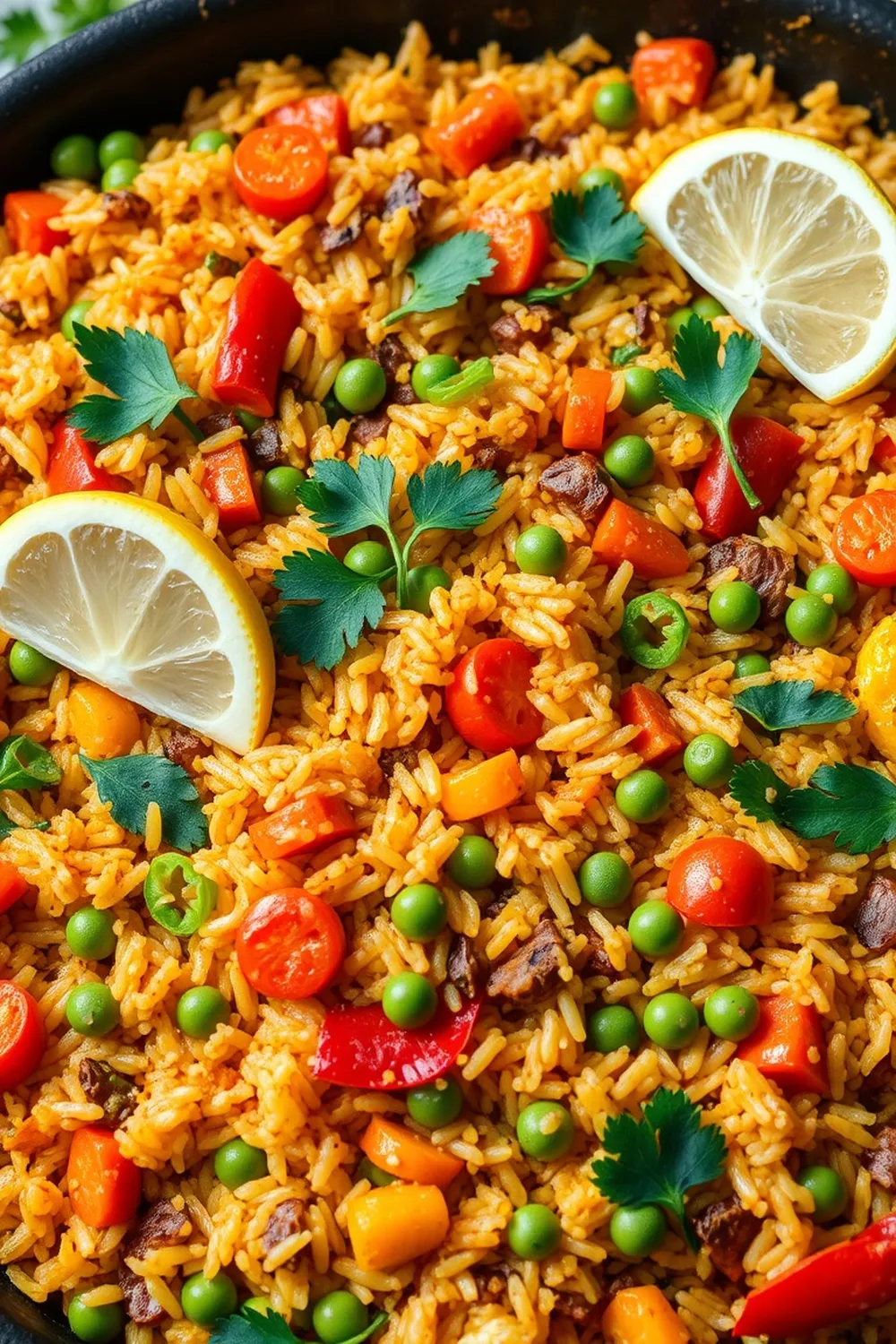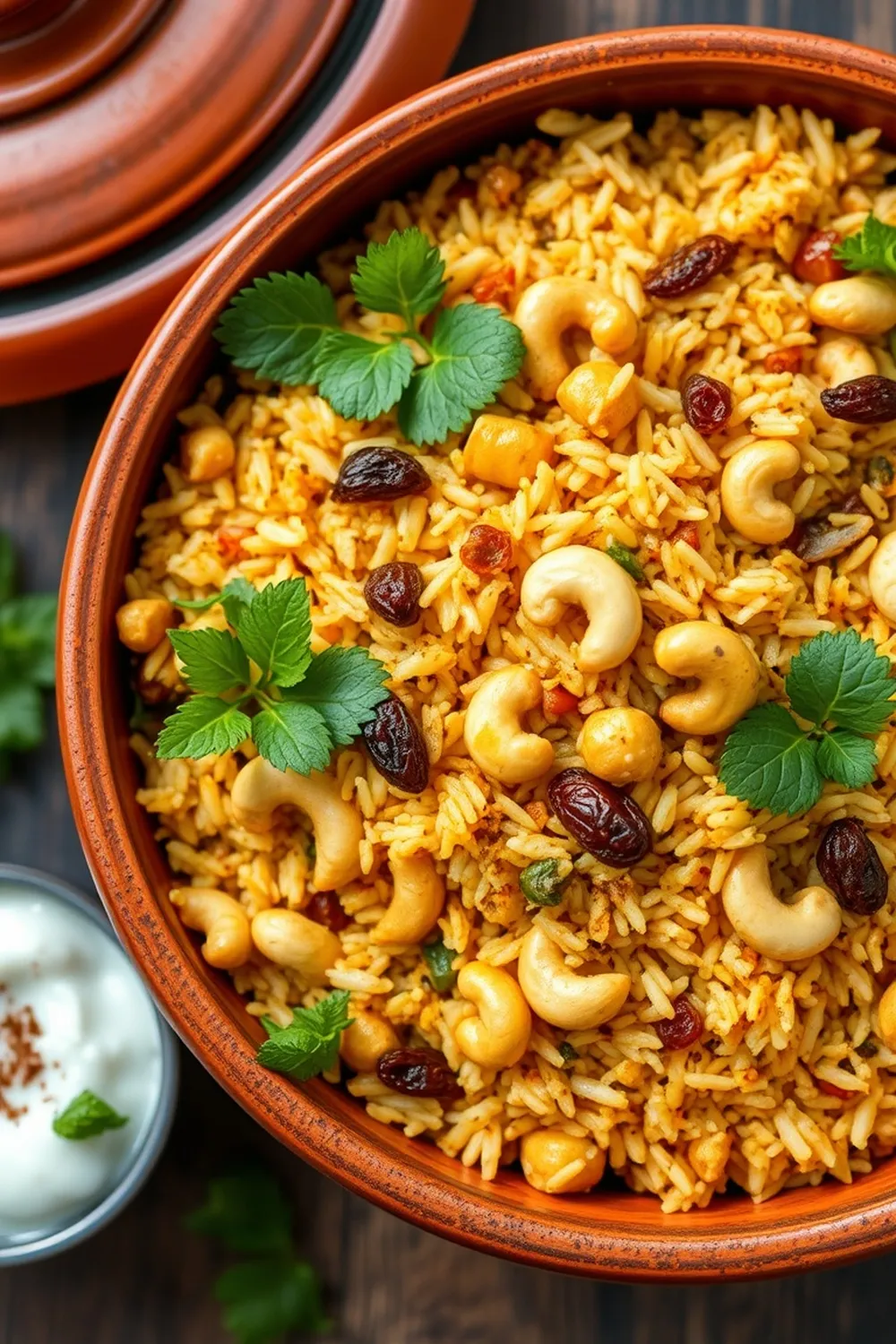- Wash and soak basmati rice for 20-25 minutes (skip if using ordinary rice).
- Heat oil in a pressure cooker. Add cinnamon stick and caraway seeds; sauté for 30 seconds.
- Add slit green chilies and sliced onions; fry until golden brown.
- Stir in ginger-garlic paste and sauté until the raw aroma disappears.
- Add mutton pieces and roast for 5 minutes to seal in flavors.
- Mix in salt, red chili powder, and turmeric powder. Cook for 2 minutes.
- Add diced potatoes and chopped tomatoes. Cook for 5 minutes until softened.
- Incorporate beaten yogurt, coriander, and mint leaves. Cook until oil separates from the masala.
- Pour 1 cup of water into the pressure cooker and seal. Cook mutton for 3 whistles on low heat.
- In an electric cooker, combine soaked rice, cooked mutton curry, 5 glasses of water, garam masala, and lemon juice. Adjust salt if needed.
- Cook until rice is fluffy and fully cooked. Fluff gently with a fork before serving.
- Serve hot with cucumber raita or onion raita.
- Calories:450 kcal25%
- Energy:1882 kJ22%
- Protein:30 g28%
- Carbohydrates:65 mg40%
- Sugar:5 mg8%
- Salt:800 g25%
- Fat:35 g20%
Last Updated on 4 months by Neha Deshmukh
Mutton Biryani Recipe: Authentic Indian Rice & Mutton Dish
Hey everyone! If you’ve ever craved that incredibly flavorful, aromatic, and satisfying Indian feast, you’re in the right place. Today, I’m sharing my family’s treasured Mutton Biryani recipe. It’s a dish that always brings back memories of special occasions and happy gatherings. Trust me, once you make this, it’ll become a go-to for your celebrations too!
Why You’ll Love This Recipe
This isn’t just any biryani; it’s a labor of love that results in unbelievably tender mutton, fluffy rice infused with spices, and an aroma that will fill your entire home. It’s a bit of a process, yes, but every step builds layers of flavor that are so worth it. Plus, I’ve included tons of tips to make it easier than you think!
Ingredients
Here’s what you’ll need to create this masterpiece:
- 1 kg mutton
- 2 glasses basmati rice (approximately 300-350g)
- 5 glasses water (approximately 1250ml)
- 2 tablespoons oil
- 2-3 medium onions, finely sliced
- 3-4 slit green chillies
- 1 large cinnamon stick
- 1 teaspoon shahi zeera (caraway seeds)
- 1 tablespoon ginger-garlic paste
- 1 teaspoon salt (plus more to taste)
- 1 teaspoon red chilli powder
- ½ teaspoon turmeric powder
- 1 cup diced potatoes
- 1 cup chopped tomatoes
- 1 cup beaten curd/yogurt
- 1 tablespoon chopped coriander leaves
- 1 tablespoon chopped mint leaves
- 1 teaspoon garam masala powder
- 1 teaspoon lemon juice
Ingredient Notes
Let’s talk ingredients – a few little things can make a huge difference!
Basmati Rice: The Importance of Quality & Soaking
Using good quality basmati rice is key. Look for long grains that are aged – they’ll stay fluffier. Soaking the rice for 20-25 minutes (skip if using ordinary rice) helps it cook evenly and prevents it from becoming mushy.
Mutton Selection: Cuts & Marbling
I prefer using mutton shoulder or leg for biryani. A little bit of marbling (fat) adds so much flavor and keeps the meat tender. Don’t be afraid of a little fat – it’s part of what makes biryani so delicious!
Shahi Zeera (Caraway Seeds): Aromatic Difference
Shahi zeera has a more delicate, fragrant flavor than regular cumin. It really elevates the aroma of the biryani. If you can’t find it, you can substitute with regular cumin, but try to find shahi zeera if possible!
Spice Blend: Regional Variations & Freshness
Biryani spice blends vary from region to region. Feel free to adjust the chilli powder to your liking. Using fresh spices is always best – they have a much more potent flavor.
Yogurt/Curd: Full-Fat vs. Low-Fat & its Impact
I always use full-fat yogurt for biryani. It adds richness and helps create that beautiful, flavorful masala. Low-fat yogurt can work in a pinch, but the flavor won’t be quite as intense.
Step-By-Step Instructions
Alright, let’s get cooking!
- Wash and soak the basmati rice for 20-25 minutes.
- Heat oil in a pressure cooker. Add the cinnamon stick and caraway seeds and sauté for about 30 seconds until fragrant.
- Add the slit green chillies and sliced onions. Fry until they turn golden brown – this takes patience, but it’s worth it!
- Stir in the ginger-garlic paste and sauté until the raw aroma disappears.
- Add the mutton pieces and roast for 5 minutes to seal in the flavors.
- Mix in the salt, red chilli powder, and turmeric powder. Cook for another 2 minutes, letting the spices coat the mutton.
- Add the diced potatoes and chopped tomatoes. Cook for about 5 minutes until the tomatoes soften.
- Incorporate the beaten yogurt, coriander, and mint leaves. Cook until the oil starts to separate from the masala – this is a sign that it’s ready.
- Pour 1 cup of water into the pressure cooker, seal it, and cook the mutton for 3 whistles on low heat.
- In an electric cooker (or a large pot), combine the soaked rice, the cooked mutton curry, 5 glasses of water, garam masala powder, and lemon juice. Adjust salt if needed.
- Cook until the rice is fluffy and fully done.
- Fluff gently with a fork before serving.
Expert Tips
- Don’t overcook the mutton! You want it to be tender, but not falling apart.
- The key to fluffy rice is the right water ratio. I’ve found 5 glasses of water to 2 glasses of rice works perfectly, but adjust slightly based on your rice and cooker.
- Let the biryani rest for 10-15 minutes after cooking. This allows the flavors to meld together.
Variations
Let’s get creative!
Spice Level Adjustment
If you like it spicy, add another ½ teaspoon of red chilli powder or a few more green chillies. If you prefer milder flavors, reduce the chilli powder or omit the green chillies altogether.
Vegan Mutton Biryani (Using Plant-Based Alternatives)
Swap the mutton for jackfruit or soy chunks. Marinate them in the same spice blend for at least 30 minutes before cooking.
Gluten-Free Considerations
This recipe is naturally gluten-free! Just double-check that your garam masala doesn’t contain any gluten-based ingredients.
Festival Adaptations (Eid, Weddings, etc.)
For special occasions, I like to add a pinch of saffron soaked in warm milk to the rice for a beautiful color and aroma. It’s a little extra touch that makes it feel even more festive.
Serving Suggestions
Serve hot with a side of refreshing cucumber raita or onion raita. A simple salad also complements the richness of the biryani beautifully.
Storage Instructions
Leftover biryani can be stored in an airtight container in the refrigerator for up to 3 days. Reheat gently in the microwave or on the stovetop.
FAQs
What type of rice is best for biryani?
Basmati rice is the gold standard for biryani. Its long grains and delicate flavor are perfect for absorbing all those delicious spices.
Can I make biryani without a pressure cooker?
Yes! You can cook the mutton in a heavy-bottomed pot on the stovetop. It will take longer, but the results will be just as delicious.
How can I prevent the mutton from becoming dry?
Marinating the mutton in yogurt and spices helps keep it tender and moist. Also, don’t overcook it!
What is the role of saffron in biryani (and can I skip it)?
Saffron adds a beautiful color and aroma to biryani. It’s not essential, but it definitely elevates the dish.
How do I adjust the spice level to my preference?
Adjust the amount of red chilli powder and green chillies to control the spice level.
Can I use leftover cooked mutton to make biryani?
Yes, absolutely! Just add the cooked mutton to the rice and spices in the final step.
What is the best way to layer the biryani for optimal flavor?
While this recipe doesn’t specifically call for layering, you can certainly add a layer of fried onions on top of the rice before cooking for extra flavor and texture.










